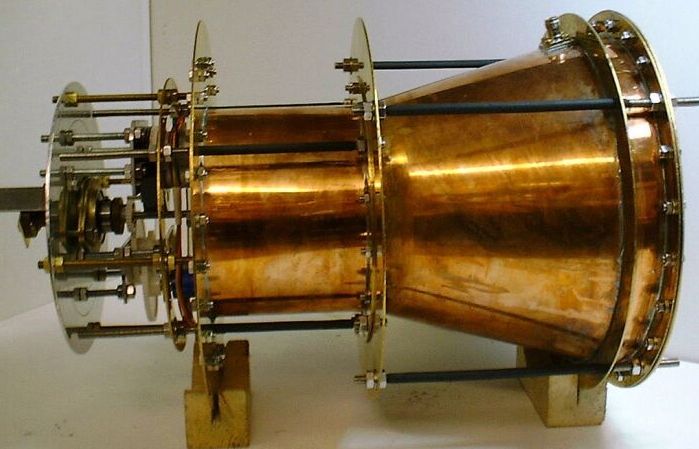
An experimental propulsion system that seems to violate the laws of physics may actually work, a new study suggests.
A controversial and puzzling engine design known as the EmDrive generated small amounts of thrust in a lab test, NASA researchers reported in the study, which has yet to be published or peer-reviewed but was recently leaked online.
The EmDrive, which was developed by British researcher Roger Shawyer more than a decade ago, generates thrust by bouncing microwaves around inside a cone-shaped chamber. According to Newton's third law of motion — for every action, there is an equal and opposite reaction — this shouldn't work, because there's no exhaust expelled out of the EmDrive system. (Think about rockets, which get their oomph by blasting superheated gases and other material out of nozzles at high speeds.) [Superfast Spacecraft Propulsion Concepts (Images)]
But the NASA team, led by Harold "Sonny" White of the agency's Johnson Space Center in Houston, did measure some thrust. Specifically, their EmDrive variant produced about 1.2 millinewtons of force per kilowatt of energy. That's about 100 times more thrust than solar-sailing spacecraft, which harness the momentum of photons streaming from the sun, are able to achieve, White and his colleagues wrote.
Like solar sails, the EmDrive requires no propellant; a spacecraft equipped with this propulsion system could generate all the microwaves it needs using solar panels. So the EmDrive could make space travel much cheaper and faster, theoretically opening up the heavens to greater exploration, advocates have said.
Don't get too excited — that's a long way from happening, if it happens at all. The new study is just a proof of concept, and further testing is needed to definitively rule out all possible sources of experimental error, White and his team said. (For example, it's possible that air within the EmDrive system could have heated up and expanded, causing some of the observed effect, the researchers wrote.)
But the new result is the latest in a series of apparent successes for EmDrive technology. Shawyer reported generating thrust with his version, as did Chinese researchers who tested their own variant in 2012. And White and his colleagues reported a positive result back in 2013 as well.
Get the Space.com Newsletter
Breaking space news, the latest updates on rocket launches, skywatching events and more!
So this seemingly impossible engine may actually work — perhaps by somehow harnessing the energy of subatomic particles that are constantly popping into and out of existence, White and his team have speculated. (Shawyer has his own ideas about what's happening inside the EmDrive, and he doesn't think Newton's Third Law is being violated at all. Check out his explanation here: http://emdrive.com/faq.html.)
Stay tuned!
You can read the leaked paper online here: https://drive.google.com/file/d/0B7kgKijo-p0ibm94VUY0TVktQlU/view
Follow Mike Wall on Twitter @michaeldwall and Google+. Follow us @Spacedotcom, Facebook or Google+. Originally published on Space.com.
Join our Space Forums to keep talking space on the latest missions, night sky and more! And if you have a news tip, correction or comment, let us know at: community@space.com.

Michael Wall is a Senior Space Writer with Space.com and joined the team in 2010. He primarily covers exoplanets, spaceflight and military space, but has been known to dabble in the space art beat. His book about the search for alien life, "Out There," was published on Nov. 13, 2018. Before becoming a science writer, Michael worked as a herpetologist and wildlife biologist. He has a Ph.D. in evolutionary biology from the University of Sydney, Australia, a bachelor's degree from the University of Arizona, and a graduate certificate in science writing from the University of California, Santa Cruz. To find out what his latest project is, you can follow Michael on Twitter.









